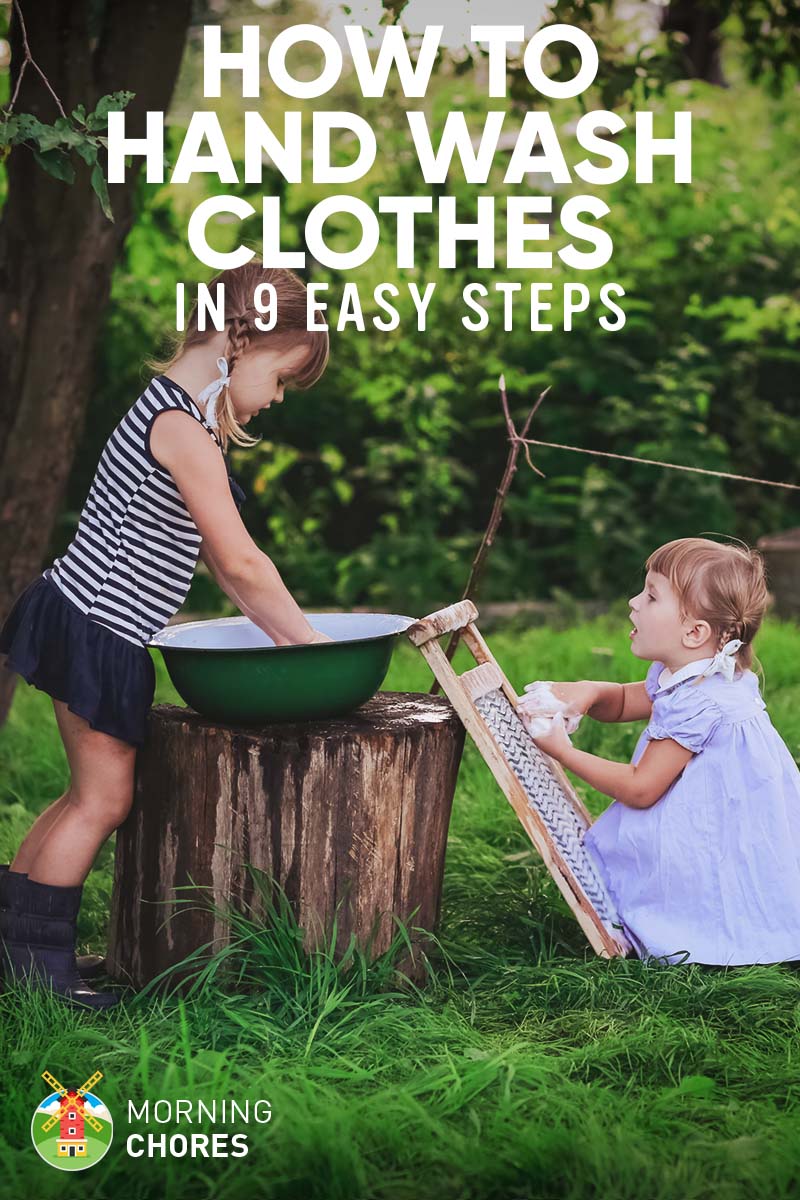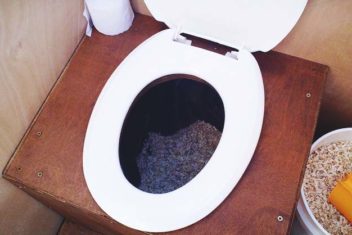About 2 years ago, I gave up my washer and dryer for a whole year. I was trying to figure out what type of homesteading was right for me, and I desperately needed to save money too.
You see, we were trying to save every penny we could to remodel our home. So I thought it would be a good idea to try and conserve water and electricity by hand washing our clothes. Well, my mother in law just about had a fit because she used to wash clothes by hand so she knew how much work I was in for.
However, I’m glad I gained the knowledge that I did in that year.
I’m going to share with you how you can properly hand wash your clothes. As well as share a few of the lessons I learned along the way that year.
How to Hand Wash Your Clothes:
1. Find the Right Wash Basin
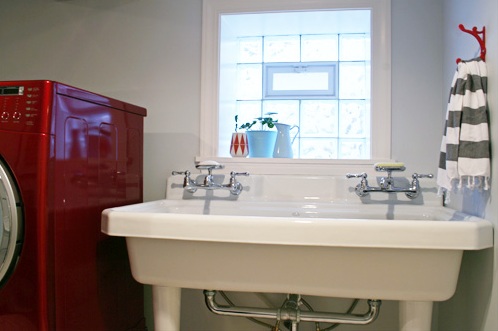
If you are going to hand wash your clothes the old fashioned way, then having the right washbasin is essential.
Some people choose to do their laundry outside and use 2 galvanized tubs. If you are okay with doing laundry outdoors, then this might be a good option for you.
However, outdoor laundry becomes an issue if you don’t want to boil water outdoors or carry boiling water outdoors for you to do the washing. Nor is it great during the winter or rainy months.
I knew I needed an indoor set-up that I could still use the modern conveniences I had available to me.
If this is more what you are aiming for, then I highly recommend going with a double basin set-up. This will cost some money. I, however, did not have that kind of money so I had to go with one single wash sink, which equated to double the work.
However, if this is all you can do at the time, then you do what you have to do in order to get the job done.
However, as I mentioned, if you have the option, I definitely recommend going with a double basin option.
2. Set-up Your Wash Area

If you decide to wash clothes outdoors, there are a few things you’ll need to consider. The first is how are you going to get water to your wash area.
Will you build a fire outside to heat water? Do you have an outdoor cook stove that you can use for heating water?
Or are you close enough to the house that you can carry hot water to your washbasin without scalding yourself or anyone else?
Then you’ll need to consider proper covering for the cold and rainy months. I have a covered back porch, which would work well for doing outdoor laundry.
However, if you choose to wash your clothes by hand indoors, then you’ll need to get your sink set-up and installed for use. After you’ve got your area all figured out, then you are ready for the next step.
3. Make or Purchase Your Wash Soap
You will need wash soap in order to wash your clothes and you can easily make your own with Fels-Naptha soap, Borax, and washing soda. You just put a cup of Borax in a bowl, a cup of washing soda in a bowl, and then grate the Fels-Naptha into the same bowl.
Then you’ll mix it up thoroughly. I usually use about half a cup per load. You can also make your own fabric softener by mixing hair conditioner, vinegar, and water to the consistency you desire. You’ll pour a couple of tablespoons of this into the wash as well.
However, you can still purchase your own laundry detergent if you prefer. In my slower seasons of life, I try to make as much of my own supplies as possible.
However, there are those seasons where life is just hectic, and I don’t have the time. I still purchase laundry detergent from time to time.
Just do what works best for you where you are in the moment.
4. Find the Right Wringer and Wash Board
This step is so important! In order to wash your clothes by hand, you’ll need a wringer. Otherwise, you’ll end up with clothes that will take forever to dry.
There are multiple options for this. The first is you can buy a mop bucket that has the built-in wringer. If you don’t have a large family, then this might work well for you.
If you can’t afford to purchase anything right now, you can still wring your clothes out by laying the wet clothes on bath towels and running a rolling pin over them. This won’t get them as dry as a wringer but will work until you can afford to do something better.
However, the option I suggest is purchasing a hand wringer. I have one, and it is what I used when I washed our clothes by hand. It worked incredibly well.
Then you’ll need to find the right washboard. I had a washboard built into my laundry sink which was great because it was one less thing I had to store when not in use.
However, a washboard similar to this should serve its purpose quite well.
5. Design the Right Drying System
There are a lot of different ways to line dry clothes and if you are planning on only washing your clothes by hand, then you’ll need a couple of systems in place to make it a functional option for the whole year.
Your first option is to hang your clothes up on a clothesline outside. This can be done by using a typical clothesline, or you could use a retractable clothesline. I actually had a traditional clothesline that consisted of 2 poles in the ground with 2 pieces of line running through the poles.
Then I also had a clothesline that my husband made that ran off of my back porch. We used one hook that was actually attached to our house. Then he placed another hook in a tree that was outside of the fenced portion of our backyard.
He then ran clothesline from the house to the tree and then back. This formed a pulley system so I could stand on the porch to hang my clothes up.
Even so, I also had 2 covered drying systems too. One was under our covered porch. My husband ran clothesline above the rafters of the porch.
Then I could just hang clothes on hangers and hang the hangers on the clothesline under the covered porch.
Plus, I had an indoor clothesline system. We placed hooks on the walls in our living room where our woodstove is. One set of hooks was placed near the woodstove while the other set of hooks were placed about halfway through the room.
This way clothes could get the heat from the woodstove and the ceiling fan. At the end of each piece of clothesline was a loop.
When I wanted to use the clothesline system, I’d just take the looped end of the clothesline off of the hook in the wall and stretch it to the other hook. Then I’d attach it with the loop to the other hook.
Then I could hang my clothes up with hangers on the clothesline, or I could use clothespins to hang them. However, your clothes will drip so be sure to place towels beneath an indoor clothesline so your floors don’t get ruined and no one slips in the water.
6. Sort Your Clothes and Wash
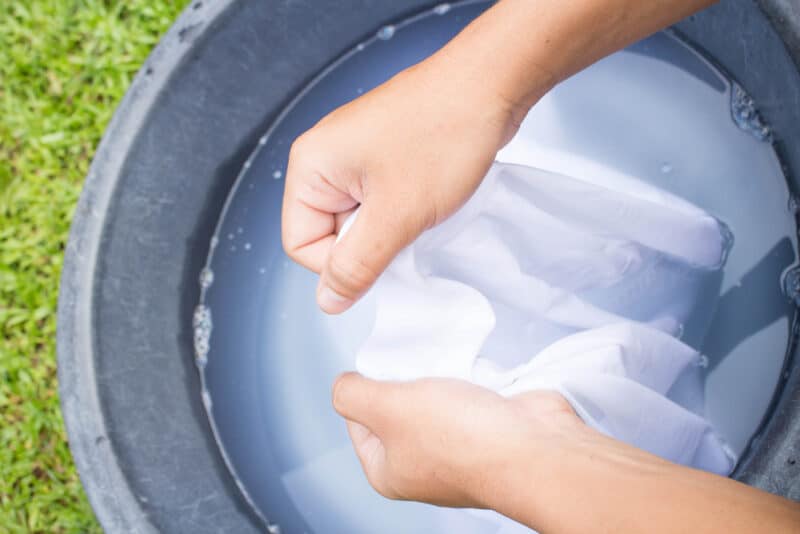
You probably won’t be able to wash as large of a load as you normally would in a regular washing machine, but you can still sort your clothes by material and color.
Then if the load looks too large, just divide it out as needed. Once your clothes are organized, then you’ll just need to fill your washbasin with water and add the soap to it.
Now, if you have a second washbasin, go ahead and fill it with regular cold water. Do not add soap or any other substance to this water as it will be used for rinsing your clothes.
You’ll begin the washing process by finding in stains in the load you are washing. Treat the stains before dropping the clothes into the sink. After you’ve treated the stains you’ll place the clothes in the washbasin with the soapy water.
Then allow your clothes to soak for about 10 minutes. This lets the dirt loosen.
Next, you’ll swish the clothes around in the water repeatedly for about 10 minutes or so. The clothes beating up against each other will pull the dirt out of them. My mother in law called this motion ‘chunking’ your clothes up and down.
We called it this because it makes a chunking sound. So roll up your sleeves and prepare to get wet. It is actually a great stress reliever.
Then you’ll have to find any soiled spots on the clothes and scrub them on the washboard until the dirt or stain is gone.
7. Wring, Rinse, Wring
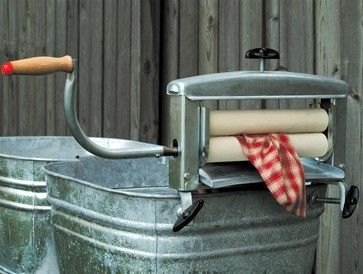
After you’ve worked out all of the stains and feel like your clothes are clean, you are ready to start the wringing process.
You’ll feed one piece of clothing at a time through the wringer. This is great exercise as it will really work your arms. After you run the clothing through the wringer, it should flop right into the rinse water. You’ll see all of the dirty water being pulled out of your clothes.
I should mention that you need to watch your fingers. I know there were times I’d be so busy feeding clothes into the wringer that I’d not pay attention and feed my finger into the wringer too.
So watch those hands. After the clothes are in the rinse water you can allow them to sit for a while. I would usually change my wash water after every few loads. This meant my clothes were soaking in the rinse water while I was running a new batch of wash water.
However, when I felt like the clothes had soaked long enough in the rinse water, I’d run them through the wringer again and this time they would land in the laundry basket to be hung up to dry.
8. Hanging Your Clothes Up to Dry
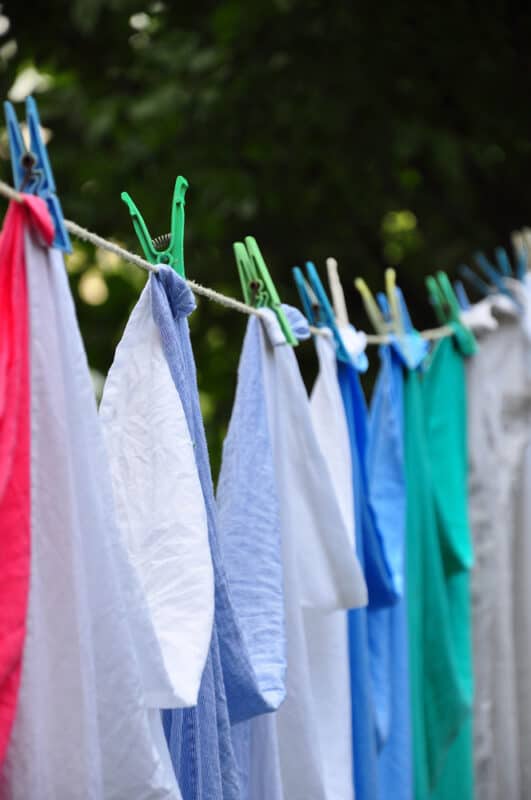
When you hang your clothes up to dry there are a few tricks. You want to hang shirts up by their tails so you don’t see the clothespin marks on them when wearing them. And you’ll take a small amount of fabric to clip them on the line with. Clothes dry faster this way.
However, you’ll have to hang pants by the cuffs with only a small amount of fabric so they’ll dry faster and not leave unwanted marks in the clothing.
You’ll use a small amount of the fabric on a towel to hang it straight across. However, for the bedding, you’ll have to divide in half and hang it over the clothesline otherwise it will drag on the ground.
However, the biggest lesson I learned when line drying my clothes is to make sure that your heaviest items go at the end of the clothesline and the lighter items go in the middle. If you don’t hang your clothes this way, your clothesline will probably droop and clothes will touch the ground which makes them dirty again.
9. Shake and Fold
After you’ve felt your clothes to know they are dry, you’ll need to go around and collect one item at a time. Be sure to use a holder for your clothespins. Most of them come with a hanger attached to the bag so they can run down the clothesline with you.
Once you get the piece of clothing off of the line, you’ll shake it out to avoid wrinkles and then fold it neatly in the clothes basket.
Then you’ll take it inside to hang it up or iron it if needed. Don’t be alarmed if your clothing isn’t soft like it came out of a dryer. It probably won’t be, but you just washed clothes without a machine so you probably won’t mind that much. I know I didn’t.
Lessons I Learned:
As I mentioned earlier, I learned a lot in the year that I gave up my washer and dryer. Here are the lessons that stick out the most to me:
1. Off-Grid Isn’t For Everyone
I used to think that just anyone could go totally off-grid and live without any modern convenience. I no longer feel that way after this year-long experiment. It has to be a mindset and not everyone has (or wants) that mindset.
Honestly, I have a lot more respect for people that do live totally off-grid now because I know how hard they truly work. Something so minuscule as doing laundry is a very physical task if you live off-grid.
After my experiment, I still want to go off-grid but in a different way. I like the idea of solar panels so I can still keep some of my modern conveniences.
However, I’m also very thankful that I was able to invest in the supplies to wash my family’s clothes by hand and also gain that knowledge so now if I’m ever in a situation that I have to wash clothes by hand I’ll know how to and be ready.
2. Line Dried Clothes Feel Different
As I already mentioned, line-dried clothes feel different. Towels and blue jeans are very rough. You’ll have to consider this if you have small children because it might be rough on their skin, especially if they aren’t used to it.
However, if you have a dryer, you could line dry them and then pop them in the dryer for a few minutes. This works wonderfully to soften materials up.
3. Homesteading Is Healthy
The longer I homestead, the more convinced I become of this being the best choice for my family. Though I take the easy way out on laundry and use a machine to wash our clothes now, I still use my clotheslines on pretty days.
My kids enjoy hanging the clothes out with me and it keeps us very active. Still, if you wash your clothes by hand, you will get plenty of physical activity and lots of fresh air while hanging them out to dry.
It just goes to prove that homesteading can be a very healthy and rewarding lifestyle.
4. Hand Washed Clothes Are Cleaner
I will say that even though I don’t hand wash my clothes on a regular basis anymore, in my opinion, hand-washed clothes are cleaner.
Which has made me inspecting and treating my machine washed clothes more thoroughly because I have higher expectations.
Truthfully, when I’m older and don’t have so many bodies in my house that produce a mountain and a half of laundry in a week, I think I’ll go back to hand washing my clothes because of the cleanliness factor, the activity level, and the great stress reliever that it is.
5. You Can Hand Wash Your Clothes Differently
Throughout that year of handwashing clothes, I learned that you can wash your clothes differently. There are lots of off-grid washing systems that make this task easier.
However, one method I’m familiar with is a wringer washer. After my mother-in-law watched me wash a family of five’s clothing a few times a week, she just about had a breakdown. She was so worried I was going to wash myself into the ground.
She went bargain hunting and found a great wringer washer for me. My husband had to make a few minor repairs, but I would plug it in and wash clothes on my covered back porch.
It did the handwashing part for me, but I still had to do the wringing, rinsing, and hanging up. It did a great job too!
If you want to wash your clothes without a modern washer but aren’t sure you want to trade that washing machine in for a washtub, then you might want to consider using a wringer washer.
As I mentioned, I don’t use a wringer washer or wash my clothes by hand anymore. I already alluded to the fact that with my family of growing boys the load just became too much for me.
I went back to using my modern washing machine, but I learned so much in that year. Even if you don’t want to wash your clothes by hand consistently, I still recommend that you know how to do it because you never know when you might need to. It is great knowledge to have.
